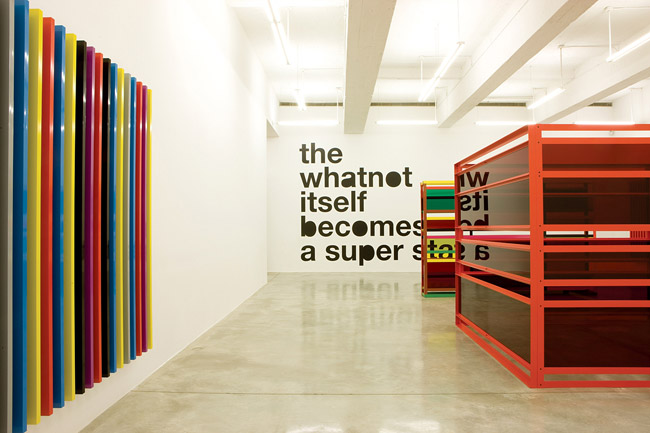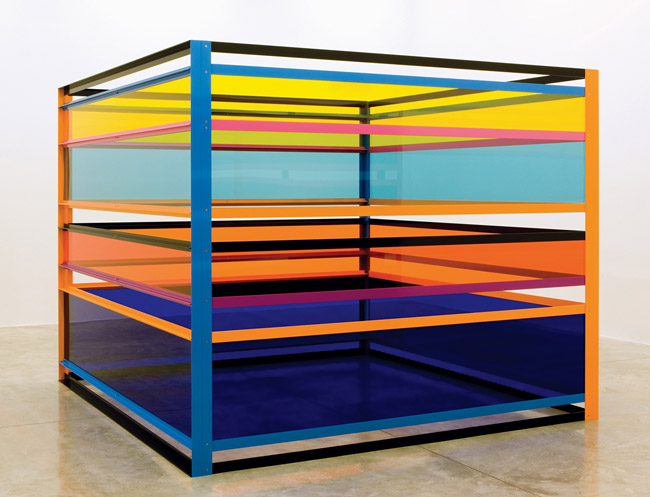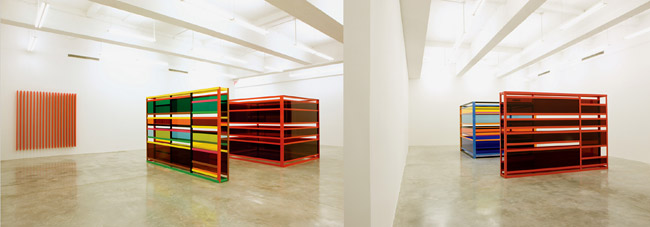This is an archive of the ArtCat Zine, 2007-2009. Please visit our new project, IDIOM.
Liam Gillick at Casey Kaplan

The State Itself Becomes A Super Whatnot
Liam Gillick
Casey Caplan - 525 West 21st Street New York, NY
8 May 8 - 14 June 2008
Recent economic and political crises, such as the sub-prime mortgage fiasco, have called attention to the problematic position of the nation state in contemporary global culture. The current American recession, whose genesis lies in the unprecedented growth of liquid capital in the global marketplace, and a complex series of obscure banking and investment strategies, has ended with United States government propping up investment capital, such as Bear-Sterns, in an effort to avoid a projected global meltdown. The oft-repeated explanation was that Bear-Sterns was "too big to fail." That is, its connections with the global marketplace ran so deep that a collapse of the company would set off a domino effect, wreaking worldwide financial havoc. The government must therefore protect this corporate citizen, or risk endangering its own position of power. The penetration of global capital into the apparatus of the state leads one to ask whether or not it is the tail that wags the dog. Liam Gillick raises some of these issues with The State Itself Becomes A Super Whatnot, his new solo show at Casey Kaplan Gallery. Gillick has made a career of repurposing minimalism and conceptualism into neatly designed objects embedded in complex theoretical narratives that are dispersed through the artist's prolific writings, performances, and talks.
His biggest formal debt is perhaps owed to Donald Judd, whose works Gillick’s on view here most resemble, and whose overbearing critical practice is evoked by Gillick’s complex theoretical interpretations of his own work. Unlike Judd’s criticism, which was always intended as supplemental to what he considered his actual artistic production, Gillick’s critical and theoretical writing is an essential element of his artistic practice. In blurring the lines between artistic production and the disinterested gaze of the cultural critic he reveals that the motivations and strategies of the critic are as much an act of creative agency as that of the artist himself.

To that end, he has created the long running potential, or unwritten, text, Construcción de Uno. This unwritten text never completely reveals the artist’s intentions, but positions a hermeneutics whose unquantifiability acts as a buffer for those critics who would seek to reduce the artist’s practice to their own terms. He has revealed a few details about this text, however: one of the principle scenarios of the text, whose narrative frames this exhibition, follows the former workers of an experimental Volvo manufacturing plant located in Brazil who return to the workplace after it has been decommissioned by Ford. There they spend their time producing elegant theories on labor equivalence and begin to refashion the site as a testing ground for new models of production.
Gillick presents the abstract objects of the exhibition as symbolic or metaphorical signifiers in the order of his narrative project. It is a knowing reversal of the critical fortunes of Judd, who during the sixties and seventies was able to convince the art world that his works were metaphysical expressions of a phenomenological pure abstraction, until a number of postmodern critics noted that these works seemed to exude a certain industrialized machismo.
Like Judd’s objects, Gillick's works are brightly colored manufactured items. In this exhibition they tend to follow three major forms: a boxy corral-like shape of painted aluminum bars and inset with plexi-glass panes, a free-standing wall-like shape also formed of aluminum and inset with plexi-glass panes, and an aluminum wall relief. Each of these shapes has a twin in one of two gallery spaces, painted in either a conflagration of bright day-glo colors or a deep red.
If Judd’s work was criticized as a representative of a kind of Western industrialized hegemony, then in Gillick’s work that criticism becomes an elemental component of his narrative. The manufactured aesthetic of minimalism’s abstract objects came to literally represent the processes of industrialization through an aesthetic demonstration of the virtues of that production; but since the eighties Western industry has increasingly shifted overseas. Western capital has morphed into an abstract information and management economy, and the aesthetics of minimalism have become tinged with a quaint nostalgia for the age of an industrialized economy and culture. The Construcción de Uno project allows Gillick to frame that historical critique of minimalism, which is inherent in the aesthetic of his own objects, and begin a critical discussion of our post-industrial culture. He argues that the models of decision making in late capitalist society, with their endless subcommittees, actions farmed out to sub-contracted government subsidiaries, and dallying scenario planning that advocates status-quo thinking, prevent any real reform.
Gillick doesn’t intend to simply refer to those problematic issues, but offers a site within which to examine them. The screens and corrals form a spatial representation of his theoretical concepts, materialized into abstract forms whose suggestive blankness is intended to propel conversation towards new utopian models.

"Utopia" is not a word the artist uses lightly; of the collaborative 2003 Venice Biennale project by Molly Nesbit, Hans Ulrich Obrist and Rirkrit Tiravanija, Utopia Station, in which Gillick participated with a host of other artists and thinkers, he wrote: " …if we are working in a post-utopian situation, how are things still agreed, planned and developed and who controls these processes? And if the situation is effectively post-utopian in terms of the absence of functional alternatives does the word ‘utopian’ only exist as an accusatory for cultural workers now?" He suggests that the proper alternative space could provide a platform within which to debate the pejorative aspects of utopian ideals, and to propose new ones. Utopia Station was a testing ground where interaction could inspire progressive dialogues, and it made active use of that collaborative invitation, with the contributions of over 160 artists.
Here it is only the forms of modernism that meet the gaze of the viewer, the failure to achieve the ideals they once represented reflected in their shiny Plexiglass surfaces, the materials alienated from the driving ideological thrust of the modernist project. As Gillick states, "We are all caught in the scenario play of late capitalism." His work is itself a deferral, a place to test for future scenarios, and a zone of endless argument. Which may be the point — to encapsulate the problematic of the current situation in the work — but then, one wonders whether his radical critique is merely window dressing or a call to action.
In traversing the exhibition site, one finds a reversal of the exhibition's title, also boldly inscribed on the wall: "The Whatnot Itself Becomes A Super State." His point, that there is a cyclical relation between the products of the state — that is, the invisible manufacture of order and material relations — and the manner of the state's production, could as well be applied to his own critique: Gillick's tastefully designed forms seesaw from the radical discourse that he carefully cradles them in and back to the shiny commercial objects that finance the intellectual’s dream.
ZINE
HOME
TIPS / COMMENTS
CATEGORIES
CONTRIBUTORS
- Greg Afinogenov
- B. Blagojevic
- Adda Birnir
- Susannah Edelbaum
- Julie Fishkin
- Paddy Johnson
- Jessica Loudis
- Christopher Reiger
- Andrew Robinson
- Peter J. Russo
- Blythe Sheldon
- S.C.Squibb
- Hrag Vartanian
